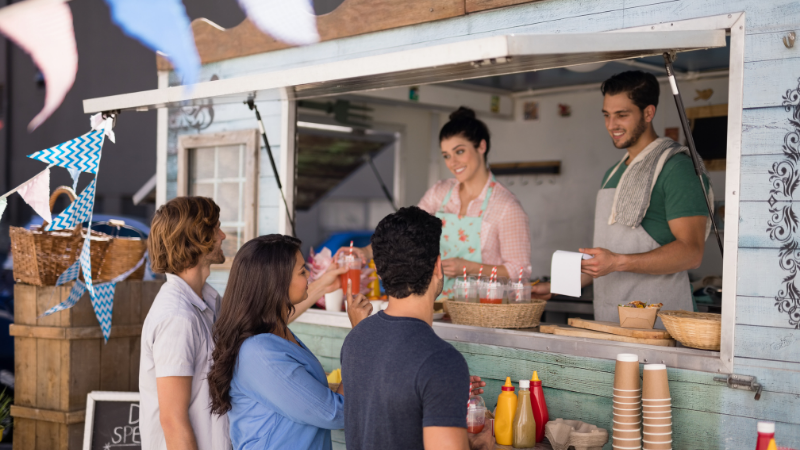
Digital Donations Save Time and Strengthen Your Non-profit’s Mission
Digital donations help Canadian non-profits raise more money, save time and earn donor trust through seamless, secure giving.

They may appear overnight and disappear just as quickly, but pop-up shops have become one of the most powerful tools for grabbing customer attention.
In Canada, demand for pop-up spaces has grown quickly since the pandemic, with more small and local businesses using them to reconnect with customers. These short-term setups make it possible to showcase products, test new ideas, and build real connections—without the weight of a long lease.
Even if you’re running a permanent brick-and-mortar store, food truck, or service-based business, there’s plenty to learn from the pop-up playbook.
A pop-up shop is a temporary retail space, typically lasting only days or weeks, designed to deliver a one-of-a-kind, limited-time shopping experience that excites customers and sparks urgency. They might take over a vacant storefront, set up at a weekend market, or appear inside another business. The goal? Drive sales, generate awareness, and connect with customers in a fresh and memorable way.
Pop-ups are known for:
Limited-time urgency: Customers know they need to act now or miss out.
Creative experiences: Themed setups, exclusive products, and immersive displays.
Agility: Quick to set up, pivot, and pack down, with no long-term lease required.
A compelling example? Picture a local bakery setting up a short-term kiosk in a shopping mall to debut an exclusive line of seasonal pastries. Rather than filling the space with their usual products, they spotlight just a few limited-edition flavours, presented with photo-worthy touches like a decorated counter and branded packaging. Shoppers are drawn in by the smells and samples, and many make impulse purchases knowing the kiosk won’t be around for long. As photos and mentions trickle onto social media, the bakery leaves not only with extra sales but also with direct feedback on which flavours resonate most—insights they can carry back to their main location.
Pop-ups are not one-size-fits-all. Depending on your goals, you might choose:
Standalone storefronts: A short-term lease of a vacant retail space. Perfect for testing a new neighbourhood, hosting a full brand takeover, or creating high visibility on busy streets.
In-store pop-ups: A temporary setup inside another business, often used for collaborations or smaller brands leveraging the traffic of larger retailers.
Market stalls or kiosks: Pop-ups in markets, malls, or transit points that let merchants tap into existing foot traffic with a small, flexible footprint.
Mobile pop-ups: Shops set up in trucks, trailers, or vans that can move between locations. This structure is great for reaching different neighbourhoods or events without being tied to one spot.
Event or festival booths: Temporary spaces or displays at festivals, trade shows, or local events, designed to capture large crowds where your target customers already gather.
Seasonal pop-ups: Short-term shops that appear around holidays or peak seasons. This includes everything from Christmas markets to summer boardwalk booths.
Urgency sells
When customers know a store won’t be around forever, they act fast—and they often buy more than planned. In fact, this “fear of missing out” drives roughly 65 per cent of purchase decisions, making it a powerful force in temporary retail.1
For your business: Create urgency with weekend-only promotions, seasonal bundles, or a short-run product launch. Even without changing locations, you can recreate that “get it before it’s gone” feeling. If demand spikes, Moneris Advance helps eligible businesses access working capital quickly, making it easier to order more stock and keep the momentum going.
Deliver experiences, not just transactions
The most successful pop-ups focus on creating a full brand experience, not just a point of sale. Interactive product demonstrations, complimentary in-store samples, or photo-friendly spaces can deepen engagement and encourage customers to stay longer.
For your business: Think beyond selling. Give your customers something to talk about and share, fueling powerful word-of-mouth marketing long after they leave.
Build buzz before you open
Pop-ups work best when people are already excited to see them. Tactics like sharing sneak peeks on social media and connecting with a local community group or influencer can quickly put you on the radar. Even with a minimal budget, stepping outside your usual marketing routine sparks curiosity and anticipation.
For your business: Run product drops like pop-up events. Set a launch date, share teasers online and in-store, and build a moment everyone wants in on.
Test, learn, and repeat
Pop-ups are a practical way to experiment. They give you the chance to test products, prices, or even new concepts in real time, while hearing directly from customers. The insights you gain can guide smarter decisions for the future.
For your business: Treat your pop-up like a live feedback loop. Ask questions, notice what customers gravitate toward, and use those learnings to fine-tune things like product variations.
Partnerships that pay off
Many pop-ups thrive on collaboration—pairing with a complementary brand to share costs and attract each other’s customers.
For your business: Whether it’s a coffee shop hosting a bakery or a florist setting up shop inside a cozy bookstore, collaborations can multiply your reach.
A pop-up isn’t just about showing up with products—it’s about creating a moment. The best pop-up shops feel more like events than stores, blending exclusivity, creativity, and customer engagement into an experience people can’t wait to share.
Whether you’re hosting a one-day booth at a local market or transforming a storefront for a weekend, success comes down to careful planning. From the story you tell to the way customers pay and interact with your brand, every detail should work together to make the experience seamless and memorable.
Create a clear concept
Define the story you want your pop-up to tell. A consistent theme—from décor to packaging—makes your brand feel more intentional and cohesive.
Anchor it around an exclusive offer
Offer something customers can’t get anywhere else. This can be a limited-edition item, early access to a product, or a unique bundle. Exclusivity drives foot traffic.
Design for shareability
Every corner should be camera-ready. Think of unique backdrops, branded props, or a playful product display that encourages customers to take and post photos.
Engage all the senses
Create a sensory experience that customers associate with your brand. A signature scent, curated playlist, or sample station can make your pop-up more immersive and memorable.
Streamline the checkout experience
Nothing kills excitement faster than a long line or clunky checkout. Stay prepared and reduce friction with solutions like the Tap to Pay on iPhone with the Moneris Go app, which enables fast and secure in-person, contactless payments with no additional hardware needed.
Collect data for long-term value
Encourage email sign-ups or social media follows during the pop-up to stay connected after the event. Offer a small incentive to increase participation, like a discount code for their next purchase.
End on a teaser
Close your pop-up with a hint about what’s next. This could be your next location, upcoming product, or seasonal collection. It keeps the conversation and anticipation going.
The pop-up mindset is all about agility—reacting to trends, creating urgency, and making every customer interaction memorable. You don’t have to rent a temporary storefront to get the benefits. By building urgency into promotions, keeping your visuals fresh, and treating launches like events, you can capture the same excitement and translate it into long-term growth.
The bottom line? Pop-ups prove that customers crave novelty, exclusivity, and connection. If you bring those elements into your everyday operations, you can make your permanent business feel as exciting as a grand opening, every single day.
_________________________________________________________________________
Sources:

Digital donations help Canadian non-profits raise more money, save time and earn donor trust through seamless, secure giving.

Explore Moneris’ 2025 year in review with insights on Canadian spending trends, sports-driven economic boosts, domestic tourism growth, holiday shopping behaviour and Quebec’s Bill 72 compliance.

Turn your gas station’s payment transactions into insights that improve staffing, inventory, promotions, and customer satisfaction.

In this guide, we’ll walk you through the types of content that work best for SMBs and give you blog topic ideas you can use today.